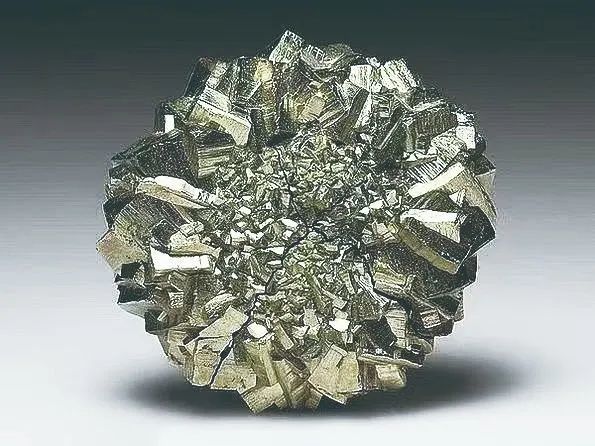The "Disguiser" of Gold - Iron Pyrite, What Are Its Uses?
Jul 27,2023
In the early 17th century, Captain John Smith, the famous British explorer, sent a whole shipload of golden-colored rocks to London for testing under the pretext of exploring the spoils of the Chickahominy River in Virginia. However, the test results were disappointing; the golden particles were not gold. Similarly, a 2015 report by Huashang Daily, titled "Mineral powder scattered on the street mistaken for gold, hundreds squat in the middle of the road to pick it up causing congestion," also attracted widespread attention. People couldn't help but wonder: a bright yellow appearance, heavy weight, dazzling luster, and a similar appearance to gold—if it's not gold, then what is it? In fact, it is a "disguise" of gold—pyrite, also known as "fool's gold."

So, what exactly is pyrite? And how does it differ from gold in terms of its properties? Let's find out together.
What is pyrite?
Pyrite is the most widely distributed sulfide mineral in the Earth's crust and a common metallic mineral. Its main component is iron disulfide, and it often contains trace amounts of cobalt, nickel, copper, gold, and selenium.
The formation of pyrite typically involves both endogenous and exogenous processes. Endogenous pyrite is mainly found in hydrothermal deposits; exogenous pyrite is found in sedimentary rocks and coal seams, often in the form of nodules, lumps, and impregnations.
The world's most famous pyrite deposit is Rio Tinto in Spain, with reserves exceeding 1 billion tons. China's proven pyrite reserves rank among the world's top, with famous deposits in Yingde and Yunfu, Guangdong; Ma'anshan, Anhui; and Baiyin, Gansu.
What are the differences between pyrite and gold?
In terms of color, both have a metallic luster, but with different shades of yellow. Gold is silver-yellow and golden, while pyrite is grass-yellow. Gold only shines under sunlight reflection, while pyrite itself has a metallic luster and brightness.
In terms of shape, gold is often found in irregular flakes. Pyrite belongs to the isometric crystal system of sulfide minerals and often occurs in cubic, octahedral, pentagonal dodecahedral, or massive aggregates.
In terms of hardness, pyrite is harder than gold. Pyrite has a hardness of 6 to 6.5, while gold has a hardness of about 2 to 3. When pyrite is struck with a hammer, it shatters like glass, while gold is one of the most ductile and malleable metals and can be hammered into any shape without breaking. When scraped with a blade, gold can be scratched, while pyrite cannot be scratched; it will only flake off.
In terms of weight, gold is a heavy metal with a specific gravity of 19.3 g/cm3, while pyrite is a light metal with a specific gravity of 5.0 g/cm3. When the same volume of gold and pyrite are placed together, the weight of gold is about four times that of pyrite. When held in the hand, gold feels particularly heavy, while pyrite is somewhat "short-weighted" compared to real gold.
In addition, gold and pyrite can also be tested by the streak they leave on an unglazed porcelain plate. Gold leaves a golden yellow streak, while pyrite leaves a greenish-black streak.
What are the uses of pyrite?
For pyrite, "fool's gold" is a rather endearing nickname, but one should not underestimate its contribution to human society. The value and significance of pyrite are, in a way, not inferior to gold.
Industrial uses: Pyrite is a very important chemical mineral raw material, most commonly used to produce sulfuric acid. Some are used in the chemical industry to produce sulfur or other sulfur-containing compounds. In addition to its important uses in the chemical industry, it also has important uses in the rubber, papermaking, and match industries. In particular, in the defense industry, it is used to produce various bombs and smoke screens.
Ornamental value: Pyrite has a smooth, flat surface, delicate shape, and golden luster. Due to its unique shape and color, it has high ornamental value and is now a frequent visitor in the gemstone circle.
Medical uses: In traditional Chinese medicine, pyrite is called "natural copper," usually crushed or calcined, and also known as "stone marrow lead." The medicinal value of pyrite is mentioned in pharmacopoeias such as "Ri Hua Zi Ben Cao," "Kai Bao Ben Cao," and "Yu Qiu Yao Jie," with therapeutic effects including dispelling blood stasis and relieving pain, mending broken bones, treating injuries from falls, broken tendons and fractures, blood stasis pain, accumulation, goiter, sores, and burns.
Geological uses: Pyrite is not gold, but it has a close relationship with gold. A recent article published in American Mineralogist, an important journal in the field of mineralogy, shows that pyrite is one of the most important gold-bearing minerals in various hydrothermal gold deposits. Its structural characteristics, trace element composition, and sulfur isotope composition record a large amount of information about the ore-forming process. The "mineral probe" of pyrite provides a new window for exploring the genesis of gold deposits and finely depicting the gold mineralization process.
Because pyrite can easily be mistaken for gold, people are often deceived by "fool's gold," leading to misidentification. Therefore, it is important to distinguish between the two in daily life.
Source: China Mining News (Please contact the administrator for deletion if there is any infringement)







